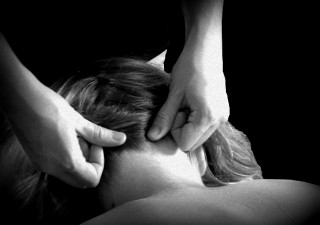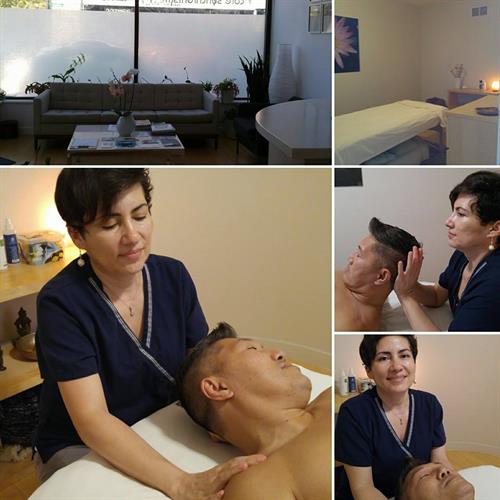 Using techniques and strategies specific to your needs
Using techniques and strategies specific to your needs
Neuromuscular Therapy (NMT) can help you figure out the likely cause of your non-traumatic neck pain, and help you recover from neck injuries, too. Based on a thorough posture and movement analysis to spot the imbalances and break the dysfunctional cycle. Working through the body using specific techniques, your trigger points will be released in a systematic manner.
Integrating NeuroKinetic Therapy™ corrective movement system protocol works brilliantly for recovery by re-programing your body to use the treated area(s) efficiently.
This is a very powerful combination that breaks old harmful/compensated movement patterns takes you to the next level and improves healing.
Reviewing the anatomy of your pain
The space between your shoulders and your head is an impressively complicated area, with cervical vertebrae, intervertebral discs, glands, nerves, lymphatic vessels, and cardiovascular structures, not to mention your spinal cord. That large, heavy orb (your skull) resting on top of the relatively small, spindly cervical spine, presents real challenges to keeping your neck healthy and pain free.
The neck is particularly vulnerable to sports injuries because of the structure of the cervical spine, the weight of the skull, and the radical and abrupt increase in range of motion between the shoulders and the neck (C-6/C7).
Neck pain stems from poor posture, whiplash, bad ergonomics and falls and blows to the head
The results are reduced and painful range of motion, inability to lift your head off the pillow, shooting pains in your shoulder, neck and head, and numbness and tingling in the arm and hand. People who sit at their desks looking down for too long will cause the muscles in the back of the neck to spasm. At the same time, the muscles in the front of the neck will weaken. Until those “front” neck muscles become functional again, the “back” neck muscles will remain tight and painful.
In addition, you may experience headaches, upper back and shoulder pain, low back and neck pain, knee pain or a tender area that may or may not refer pain to another part of the body. You may also experience “the injury that never fully healed.” Areas with trigger points and/or pain will create postural and movement imbalances that will eventually lead to chronic pain, injury, degeneration or nerve entrapment.
Treatment goal is to re-establish a balance between the nervous and muscular systems thereby balancing your structure. Schedule your appointment to experience an effective way in relieving pain and restoring function throughout the body.
Common sources of neck problems include:
1. Sitting postures (for example, your work station/computer, and your overly cushy sofa at home)
2. Stress (mental and emotional) induced pain and dysfunction
3. Injuries
4. Sleeping positions – this involves figuring out the right relationship between the width of your shoulders, your mattress and your pillow, in addition to how you situate your body in the bed.
Some of the most common injuries/dysfunctions of the cervical spine are: Tightness, pain, postural distortions, and loss of range of motion from an abnormal cervical curve: Negative changes to the cervical curve are becoming increasingly common due to the increased number of hours spent at computers when proper sitting postures (and other work-station factors) have not been established.
Children during their growth years are literally overburdened with unreasonably heavy book bags which put undue stress on their upper-back, shoulders and neck. Computer use by teenagers (i.e., during their growth years) is a potentially disastrous trend, because if improper sitting postures are sustained over enough time, then the actual “shaping” or growth of the vertebral discs can be negatively affected; thoracic vertebrae fail to grow into an appropriately rectangular shaped structure, and instead mature in a wedged shape creating a slumping or “humped” mid and upper back.
Whiplash: This describes a situation where the head is accelerated first into hyper-extension (thrown backwards) and then, very quickly, thrown forward. The most common occurrence of whiplash is associated with car accidents, but it’s easy to see the same mechanism in many sports accidents as well. More commonly, there is an “external contact” that initiates the first movement outside the normal range of motion, but the same scenario can occur with a “simple” fall to the ground. Whiplash can be mild or very severe, and can involve pain, headache, tingling down into the arms, ringing in the ears, difficulty concentrating or remembering, stiffness, weakness, or dizziness. Associated shoulder and upper back pain is common.
Whiplash dysfunctions usually heal within a few weeks, but if the level of disruption to muscle/tendon/ligament or joints is sufficient, then the condition can become chronic and lead to quite severe problems down the road, including TMJD (Temporo-mandibular Joint Dysfunction.) If whiplash symptoms do not subside after home therapy, i.e., RICE (rest, ice, compression and elevation) and appropriate Neuromuscular Therapy treatments, then seek further diagnostic help from your physician.
Neck Sprains: This condition occurs with whiplash, and sports injuries as well. Falls, or contact trauma are generally involved. A sprain describes the stretching or tearing of ligaments that result from the boney structures being taken beyond their maximal range of motion. Sprains may not be noticed immediately, but can show up over the next day or two after the incident. Symptoms are very similar to whiplash, and RICE (rest, ice, compression and elevation) is usually suggested for mild to moderate cases, along with appropriate applied Neuromuscular Therapy.
David was helped with chronic neck pain
 “In 2008, I had my 4th and 5th vertebrae fused in my neck. I found out then that I might continue having problems with my spine and other surrounding areas. I have been on pain relievers and muscle relaxers to keep my back from hurting until mid 2010 when a friend referred me to Mara. She was explaining that Mara was different, I was like, ya ya ya.
“In 2008, I had my 4th and 5th vertebrae fused in my neck. I found out then that I might continue having problems with my spine and other surrounding areas. I have been on pain relievers and muscle relaxers to keep my back from hurting until mid 2010 when a friend referred me to Mara. She was explaining that Mara was different, I was like, ya ya ya.
Well, I was amazed at what she did for about 8 months, then I got off track with her due to another surgery. Well, my neck started hurting really bad again so I went to my Neurologist. I was sure I was in for another surgery. He said I was not near there yet but I needed to take some preventative measures. I showed him Mara’s card that explained what she did and he had my Primary Care Physician write me a prescription for Mara’s services.
He told me that what she did would keep me from having surgery for a long time. He explained that it was medically necessary and a proven treatment for what I was dealing with. Well, 3 weeks later and my pain is gone and I am feeling great again. Honestly, what she does works and it lasts!! Now I have the backing of my PCP and my Neurologist. She is awesome. Give her a chance and you will feel a lot different with in a visit or two” David Smith
Disclaimer: The information found through out this website is for educational purposes only
[schedule_now]
